
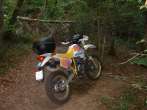
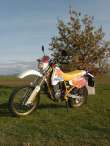
This page is about the Suzuki DR350 that we used between 2003 and 2006. Originally we acquired this motorcycle for my girlfriend and sometimes she allowed me to take her DR350SH for a ride ;-). I liked this bike - it's a lightweight (135 kg) machine that is very easy to handle.
Please note that this bike has been sold. Except for the material on these pages, I do not have any documentation of the bike left, so please do not ask me where to find parts etc. I suggest to ask your friendly Suzuki dealer ...
One of the strengths of "Dr. Little" is indeed its combination of low weight, an excellent suspension and a powerful yet cultivated engine. The bike is well suited for a beginner (provided your feet touch the ground at rest ;-), and a the same time an experienced rider will appreciate its handling qualities and the suspension, which allow to ride across rough ground at a pretty high speed (nevertheless, we use this bike as an Enduro ... and do not abuse it as a MX bike ;-)
Under normal use, gas consumption is surprisingly low for a motorcycle with about 28 HP: 3...4 l/100 km, usually closer to the lower end. Yet ... the small gas tank of only 9 l (2 l reserve) still calls for a refill every 160...200 km. And this is about the longest interval one can do on this bike without a rest, as the seat is rather hard and narrow - yet another indication that the DR350 was probably build more for the MC ground than for long-distance touring, albeit she can do both very well.
The SHC model of the DR350 series is equipped with an excellent upside-down fork. A detail that may owners ignore is that you can adjust its compression damping: On the bottom of the front fork, there is an adjuster (eventually hidden under a rubber cap; on the left side you may need to remove the protection of the brake line). Maximum damping is reached if this adjuster is turned fully clockwise. Stock setting is 7 "clicks" out, which is pretty soft; I usually ride with about 5 "clicks" out.
A particular problem in our case was that the previous owner had done a lot of modifications - not always to the best. Among the positive modifications was the installation of a steel-lined brake line, but I would have preferred that he would not have removed the SHC (Seat Height Control) - a feature that allows to vary the seat height by pumping oil to/from the shock and the fork. As we bought it, both the rear shock and the front fork had valves for pneumatically assisted suspension, with 0 bar at the front at about 2.5 bar at the rear end, but no documentation at all. I presume this was a part from "some other" motorcycle, but never found out details.
According to the User's Manual, the DR350SH is equipped with tires in the sizes 80/100-21 51P and 110/90-18 61P. These are pretty unusual sizes; as we received the DR it was equipped with Michelin Sirac in 80/90-21 48R and 110/80-18 58R. We found out much later that these tires were not strictly legal for this bike, but there exists a certificate ("Teilegutachten") from the German TÜV allowing any combination of the following front and rear tire sizes:
Among these, especially the 90/90-21 and 120/80-18 sizes are common. I equipped our DR with Mitas E07 tires, which have excellent properties both on asphalt as well as on gravel roads, no matter it the ground is wet or dry. The only downside is that the very "open" profile of the front wheel reduces braking performance somewhat. - The recommended pressure is 1.5 bar for the front and 1.8 bar for the rear wheel.
The bike is generally well equipped (H4 light, clear instruments, good footpegs), but there are also some rather annoying details, such as the complete absence of even a modest form of luggage rack. There is nothing behind the driver's seat. If you want to transport some luggage without using a rucksack, it is not easy to find a good rack for a reasonable price today.
I came across Brian Sorufka, who offers an elegant, custom-built rack for the DR350. The only problem was that shipping from Switzerland to the USA and back would have added a significant amount of cost.
To cut a long story short, we ended up with a rack that was basically inspired by Brian's proven design, but custom-built according to our exact needs by Thierry Jauslin in Tolochenaz. It exactly matched the support of the topcase (... a topcase on an enduro? Yes, it's pretty much the french way, but particularly useful in city traffic ;-).
If you drop the DR, it will land flat on its handlebars. Which means that you may break the clutch lever or, worse, the brake lever on this occasion. As a consequence, we installed a pair of handguards (from DELO) in 2004-06.
Mounting them on the stock DR handlebar required much more work than planned, as the DR has massive weights welded into the ends of the handlebar to reduce vibrations. I did not want to exchange the rubber grips completely, so after cutting off the - surprisingly tough - rubber from the ends of the grips I drilled a suitable hole and finally cut a thread M8. The handguards were delivered with a set of parts that allows to fit them to standard (read: hollow) handlebars. I cut the necessary parts off and used just the "endcaps" as spacers, so that the movement of the throttle body would not be impeded in any way. - The guards fit rather tight, but are correctly in place. On the right-hand side, the brake fluid container is touching the inner part of the guard, but this seems to be not critical and an unfortunate consequence of the "universal fit".
The DELO handguards are a low-cost alternative to other brands such as Acerbis, but they are definitively not very stable, even if they are boldly attached to the handlebar. I experienced this when I dropped the bike at rest in soft area; the ball-end of the clutch lever broke immediately (the lever was drilled a few mm from the end - see below - but I would expect those handguards to protect the levers completely from touching anything). However, a big security feature of handguards "in general" is that, in spite of their modest size, they add quite some visibility to the bike.
As an additional security measure, we drilled a small hole through the levers, just a few cm from the outer end. Should the handguards fail, this should cause the levers to break at this place ... instead of the inner side, which would leave you without clutch or brake.
In spring 2004 we acquired an oil thermometer for the DR350. It replaces the oil dip stick and gives a good indication of the oil temperature. Just for the record, I once measured the deviation between the indicated and the real temperature and found this one to be accurate to about 3°C over the range 30...100°C.
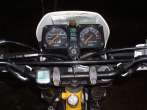 With this device, I learned that the DR requires quite some time until the oil temperature
in the upper frame reaches at least 60 °C: Under normal conditions, I need more
than 10 km of street riding for this. In contrast to this, as soon as you ride roads
at low speed, or if you are stuck in a traffic jam, the oil temperature rises quickly
and can easily reach more than 110 °C.
With this device, I learned that the DR requires quite some time until the oil temperature
in the upper frame reaches at least 60 °C: Under normal conditions, I need more
than 10 km of street riding for this. In contrast to this, as soon as you ride roads
at low speed, or if you are stuck in a traffic jam, the oil temperature rises quickly
and can easily reach more than 110 °C.
Apart from its original purpose, the thermometer has an additional advantage ... it easily indicates a too-low oil level: if the indicated oil temperature takes a very long time to reach even 50 °C, this means that the oil level does not even touch the thermometer, i.e. you are below the "L" mark. Time to add some oil!
This kind of thermometer is available at least in all major motorcycle accessory shops in Germany. This one was a "moto detail" thermometer.
By the way, checking the oil level of the DR is quite a particular topic since the engine oil tank is located in the upper part of the frame ... and when the engine is cold, most of this oil gathers in the crankcase. The original manual delivered with the DR specifies two different techniques, briefly as follows:
The point is that these two techniques may deliver different results: It happened that I measured "not enough oil" according to the dipstick technique, but when I verified this with the plug technique oil started leaking out immediately.
Using our motorcycles almost daily, I like to have a clock available. Similar to my R80GS, the simplest solution was to get a Sigma bicycle speedometer (here, a BC 800) - voilà, a clock that is vibration resistant and waterproof, has its own battery and yields yet another, accurate tripmeter.
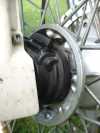 Installation on the DR350 was straightforward, once we had figured out a suitable place for the
sensor parts. Here, the reed relais found its place just on top of the original speedometer cable
entry at the hub and the magnet was glued just between two spokes at the inner side of the
wheel hub. I used brake cleaner to get a grease-free area and expoxy glue (Araldit) to fix both
parts in place.
Installation on the DR350 was straightforward, once we had figured out a suitable place for the
sensor parts. Here, the reed relais found its place just on top of the original speedometer cable
entry at the hub and the magnet was glued just between two spokes at the inner side of the
wheel hub. I used brake cleaner to get a grease-free area and expoxy glue (Araldit) to fix both
parts in place.
Due to the accurate calibration that can be performed with a bicycle speedometer, I found that the original Suzuki speedometer advances about 6 % ... in other words, an indicated speed of 100 km/h is some 94 km/h in reality. The odometer is a little bit more exact; it advances "only" about 3 %.
One caveat, related to the BC800: This model is equipped with some more 'intelligence' than its predecessors. When the wheel is not spinning for a while, it drops into a kind of 'sleep mode' where only the time is shown. If you re-start after this, the display will automatically show the trip counter, no matter what you used before. Personally, I find this slightly annoying (I would like to see the actual time, so I have to press the button five times), but according to the Sigma customer service there is no way to change this.
According to my knowledge, the DR350SH does not have any "typical" electrical problems. However, alternator defects on japanese bikes are particularly annoying: since these motorcycles are generally not equipped with a charge control lamp, defects can go unnoticed for quite a while ... until you are left with a flat battery.
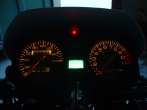 To prevent this kind of surprise, this DR received an LED voltage indicator - a simple device
to survey the charging voltage, which had already proven useful on my BMW R80GS.
It was mounted with Zip-ties right above the instrument cluster; in this picture
you can see the red LED since the engine is not running.
To prevent this kind of surprise, this DR received an LED voltage indicator - a simple device
to survey the charging voltage, which had already proven useful on my BMW R80GS.
It was mounted with Zip-ties right above the instrument cluster; in this picture
you can see the red LED since the engine is not running.
Just for the record, with the lights on and the engine running at or above 2000/min, I measured voltages of 14.2...14.5 V at the battery (14.5 V at 2000/min) - thus, the battery receives sufficient charging current already just above idle. Battery idle voltage, with ignition off, was 12.9 V (note: this is a sealed lead-acid battery). These data were obtained with the battery fully charged (a few hours after a 100-km trip), and with the engine still warm.
We acquired the DR350SHC in 2003-07.